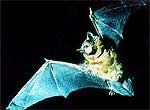 This is the latest discovery by Swiss scientists regarding the hunting techniques of bats. Typically, bats use echolocation to locate prey through feedback signals. However, when they are close to the ground, the presence of objects that disrupt sound waves forces bats to rely on their ears to “hear” their prey.
This is the latest discovery by Swiss scientists regarding the hunting techniques of bats. Typically, bats use echolocation to locate prey through feedback signals. However, when they are close to the ground, the presence of objects that disrupt sound waves forces bats to rely on their ears to “hear” their prey.
A research team led by Rhaphael Arlettaz from the University of Bern, along with colleagues from the University of Lausanne (Switzerland), monitored two common bat species: Myotis myotis (greater mouse-eared bat) and Myotis blythii (lesser mouse-eared bat). Video recordings revealed that when bats swoop down low, they limit their echolocation calls (only emitting enough to orient themselves). At this point, to track their prey, bats must depend on their highly sensitive ears. The auditory capabilities of bats are so acute that they can detect a flea jumping from one blade of grass to another.
Observations from the research team also indicated that bats hunt more effectively in flat areas compared to rough terrains. This is because the ultrasonic waves emitted by bats reflect better off smooth surfaces. In fact, when hunting over a calm lake, even when flying low to the water’s surface, bats still utilize echolocation.
Minh Hy (according to dpa)



















































